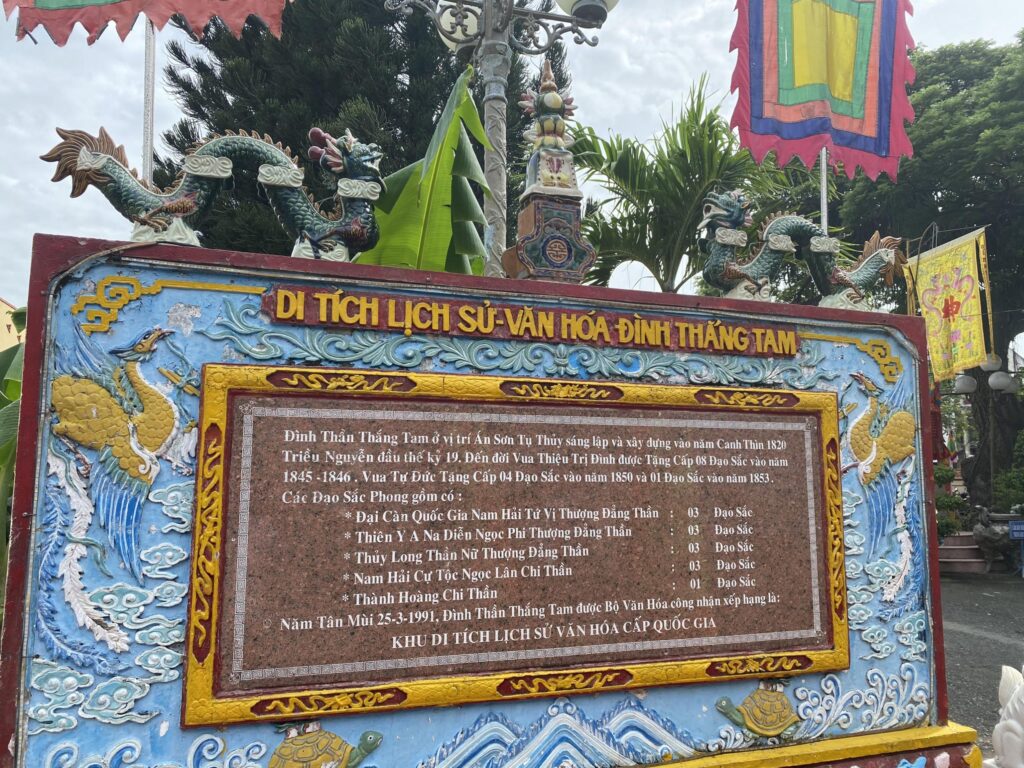The Nghinh Ong Festival and the tradition of whale worship (cá Ông) originate from the ancient totemic beliefs of coastal communities in Vietnam. This spiritual practice has been widespread along the coastline from Thanh Hoa Province to Kien Giang Province for centuries.
Every year in Ba Ria – Vung Tau Province, fishing villages organize their own Nghinh Ong Festivals, including in:
- Binh Chau Commune
- Phuoc Hai, Phuoc Tinh, Long Hai
- Thang Tam Communal Houses
Among these, the most famous and significant celebration is the Nghinh Ong Festival at Thang Tam Temple (Lăng Ông – Đình Thắng Tam).
Origins of Whale Worship
According to Cham legend, the whale deity comes from the god Cha-aih-va, who in impatience to return home after mastering magical powers, disobeyed his teacher and transformed himself into a whale. From then on, he helped save fishermen in distress by lifting damaged boats and bringing people safely to shore.
Vietnamese (Kinh) folklore tells a different story: “The Whale was created when the Bodhisattva Avalokitesvara (Quan Âm) tore her kasaya robe into thousands of pieces and cast them upon the sea to save seafarers in danger.”
Historical records from the Nguyen Dynasty also mention whale worship. When Lord Nguyễn Ánh (later Emperor Gia Long) fled to Phu Quoc during a violent storm and his boat nearly capsized, he prayed for help and survived. After reclaiming the throne, Emperor Gia Long honored the whale with the title:
“Nam Hải Cự Tộc Ngọc Lân Thượng Đẳng Thần”
(“The Supreme Deity of the Great Tribe of the South Sea”)
Because of this divine image, coastal communities revere the whale as a sacred guardian — a protector during storms, high waves, and life-threatening dangers at sea.
The Nghinh Ong Festival at Thang Tam Temple
Held annually on the 16th, 17th, and 18th days of the 8th lunar month, this is the largest and most vibrant whale-worship festival in southern Vietnam.
Inside Lăng Ông, many whale skeletons are preserved. The oldest was brought in 1868 after washing ashore at Thuy Van Beach (Vung Tau Ward). This skeleton weighs around 4 tons and measures roughly 30 meters in length.
Thang Tam Temple also preserves two royal decrees granted in 1846 and 1850 under the reign of Emperor Tu Duc.

Festival Rituals and Activities
The festival begins at dawn with a grand procession. Elders and community leaders board a beautifully decorated boat adorned with flags, flowers, and an altar honoring the whale deity. They are accompanied by a traditional five-instrument orchestra, drums, gongs, and a lively lion dance troupe.
The boat sails to a designated offshore point where offerings of incense and rice wine are made to invite the whale spirit (“Nghinh Ông”).
Upon returning to shore, the deity is ceremonially welcomed back to the temple, followed by rituals honoring the Tiền Hiền (founders) and Hậu Hiền (later settlers), recitations of prayers and royal decrees, and ceremonial offerings of tea, flowers, and wine.
Visitors can also enjoy cultural performances such as:
- Martial arts demonstrations
- Lion dance (múa lân)
- Classical Vietnamese opera (hát bội)
All accompanied by the rhythmic sounds of drums and gongs amid billowing incense smoke.
Cultural Significance
For fishermen, the Nghinh Ong Festival is a sacred occasion to pray for:
- Peace and safety at sea
- Abundant catches
- Prosperity, harmony, and lasting happiness
It is also a time to honor ancestors, express gratitude, and preserve the spirit of “uống nước nhớ nguồn” — remembering one’s roots and those who came before.








